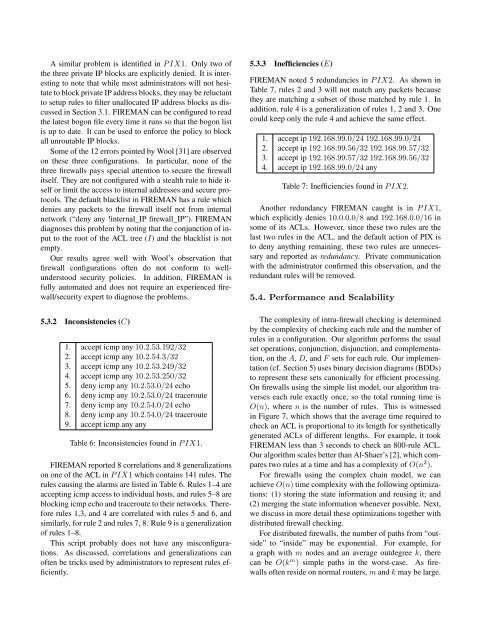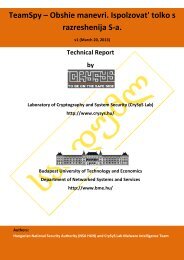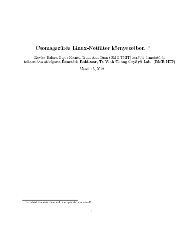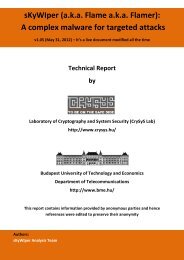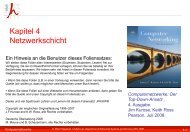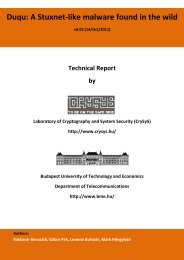FIREMAN: A Toolkit for FIREwall Modeling and ANalysis
FIREMAN: A Toolkit for FIREwall Modeling and ANalysis
FIREMAN: A Toolkit for FIREwall Modeling and ANalysis
Create successful ePaper yourself
Turn your PDF publications into a flip-book with our unique Google optimized e-Paper software.
A similar problem is identified in P IX1. Only two of<br />
the three private IP blocks are explicitly denied. It is interesting<br />
to note that while most administrators will not hesitate<br />
to block private IP address blocks, they may be reluctant<br />
to setup rules to filter unallocated IP address blocks as discussed<br />
in Section 3.1. <strong>FIREMAN</strong> can be configured to read<br />
the latest bogon file every time it runs so that the bogon list<br />
is up to date. It can be used to en<strong>for</strong>ce the policy to block<br />
all unroutable IP blocks.<br />
Some of the 12 errors pointed by Wool [31] are observed<br />
on these three configurations. In particular, none of the<br />
three firewalls pays special attention to secure the firewall<br />
itself. They are not configured with a stealth rule to hide itself<br />
or limit the access to internal addresses <strong>and</strong> secure protocols.<br />
The default blacklist in <strong>FIREMAN</strong> has a rule which<br />
denies any packets to the firewall itself not from internal<br />
network (“deny any !internal_IP firewall_IP”). <strong>FIREMAN</strong><br />
diagnoses this problem by noting that the conjunction of input<br />
to the root of the ACL tree (I) <strong>and</strong> the blacklist is not<br />
empty.<br />
Our results agree well with Wool’s observation that<br />
firewall configurations often do not con<strong>for</strong>m to wellunderstood<br />
security policies. In addition, <strong>FIREMAN</strong> is<br />
fully automated <strong>and</strong> does not require an experienced firewall/security<br />
expert to diagnose the problems.<br />
5.3.2 Inconsistencies (C)<br />
1. accept icmp any 10.2.53.192/32<br />
2. accept icmp any 10.2.54.3/32<br />
3. accept icmp any 10.2.53.249/32<br />
4. accept icmp any 10.2.53.250/32<br />
5. deny icmp any 10.2.53.0/24 echo<br />
6. deny icmp any 10.2.53.0/24 traceroute<br />
7. deny icmp any 10.2.54.0/24 echo<br />
8. deny icmp any 10.2.54.0/24 traceroute<br />
9. accept icmp any any<br />
Table 6: Inconsistencies found in P IX1.<br />
<strong>FIREMAN</strong> reported 8 correlations <strong>and</strong> 8 generalizations<br />
on one of the ACL in P IX1 which contains 141 rules. The<br />
rules causing the alarms are listed in Table 6. Rules 1–4 are<br />
accepting icmp access to individual hosts, <strong>and</strong> rules 5–8 are<br />
blocking icmp echo <strong>and</strong> traceroute to their networks. There<strong>for</strong>e<br />
rules 1,3, <strong>and</strong> 4 are correlated with rules 5 <strong>and</strong> 6, <strong>and</strong><br />
similarly, <strong>for</strong> rule 2 <strong>and</strong> rules 7, 8. Rule 9 is a generalization<br />
of rules 1–8.<br />
This script probably does not have any misconfigurations.<br />
As discussed, correlations <strong>and</strong> generalizations can<br />
often be tricks used by administrators to represent rules efficiently.<br />
5.3.3 Inefficiencies (E)<br />
<strong>FIREMAN</strong> noted 5 redundancies in P IX2. As shown in<br />
Table 7, rules 2 <strong>and</strong> 3 will not match any packets because<br />
they are matching a subset of those matched by rule 1. In<br />
addition, rule 4 is a generalization of rules 1, 2 <strong>and</strong> 3. One<br />
could keep only the rule 4 <strong>and</strong> achieve the same effect.<br />
1. accept ip 192.168.99.0/24 192.168.99.0/24<br />
2. accept ip 192.168.99.56/32 192.168.99.57/32<br />
3. accept ip 192.168.99.57/32 192.168.99.56/32<br />
4. accept ip 192.168.99.0/24 any<br />
Table 7: Inefficiencies found in P IX2.<br />
Another redundancy <strong>FIREMAN</strong> caught is in P IX1,<br />
which explicitly denies 10.0.0.0/8 <strong>and</strong> 192.168.0.0/16 in<br />
some of its ACLs. However, since these two rules are the<br />
last two rules in the ACL, <strong>and</strong> the default action of PIX is<br />
to deny anything remaining, these two rules are unnecessary<br />
<strong>and</strong> reported as redundancy. Private communication<br />
with the administrator confirmed this observation, <strong>and</strong> the<br />
redundant rules will be removed.<br />
5.4. Per<strong>for</strong>mance <strong>and</strong> Scalability<br />
The complexity of intra-firewall checking is determined<br />
by the complexity of checking each rule <strong>and</strong> the number of<br />
rules in a configuration. Our algorithm per<strong>for</strong>ms the usual<br />
set operations, conjunction, disjunction, <strong>and</strong> complementation,<br />
on the A, D, <strong>and</strong> F sets <strong>for</strong> each rule. Our implementation<br />
(cf. Section 5) uses binary decision diagrams (BDDs)<br />
to represent these sets canonically <strong>for</strong> efficient processing.<br />
On firewalls using the simple list model, our algorithm traverses<br />
each rule exactly once, so the total running time is<br />
O(n), where n is the number of rules. This is witnessed<br />
in Figure 7, which shows that the average time required to<br />
check an ACL is proportional to its length <strong>for</strong> synthetically<br />
generated ACLs of different lengths. For example, it took<br />
<strong>FIREMAN</strong> less than 3 seconds to check an 800-rule ACL.<br />
Our algorithm scales better than Al-Shaer’s [2], which compares<br />
two rules at a time <strong>and</strong> has a complexity of O(n 2 ).<br />
For firewalls using the complex chain model, we can<br />
achieve O(n) time complexity with the following optimizations:<br />
(1) storing the state in<strong>for</strong>mation <strong>and</strong> reusing it; <strong>and</strong><br />
(2) merging the state in<strong>for</strong>mation whenever possible. Next,<br />
we discuss in more detail these optimizations together with<br />
distributed firewall checking.<br />
For distributed firewalls, the number of paths from “outside”<br />
to “inside” may be exponential. For example, <strong>for</strong><br />
a graph with m nodes <strong>and</strong> an average outdegree k, there<br />
can be O(k m ) simple paths in the worst-case. As firewalls<br />
often reside on normal routers, m <strong>and</strong> k may be large.


